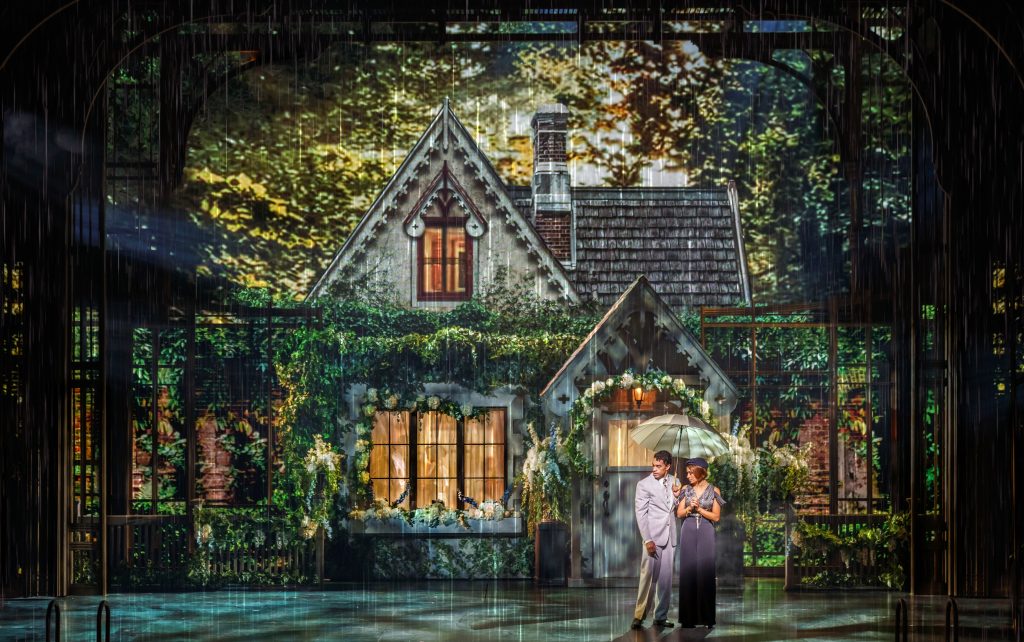2024 is poised to be quite the year for lighting designer Cory Pattak, one of the most exciting young creatives in the world of theatre.
Pattak already made his Broadway debut with Spamalot at the St. James Theatre in late 2023, and now his rightfully opulent work on The Great Gatsby will impress audiences at the Broadway Theatre beginning April 25th, 2024. With a third show slated for debut later this year, Pattak is quickly cementing himself as a sought-after lighting designer on the Broadway circuit, not to mention a legitimate Tony contender.
Pattak attributes much of his success to the collaborative relationships he has built over the course of his career. Beyond on-set collaborators like scenic designer Paul Tate dePoo, with whom Pattak has worked for over 14 years, Pattak also maintains connections with local lighting shops in Manhattan.
“They are very generous in setting up demos of fixtures to compare or find the right light for a particular project,” says Pattak. “Often certain manufacturers will come to town to show off their latest products and I try to pop in and see those fixtures in person.”
Awards Focus sat down with Pattak to discuss his creative approach as a lighting designer, as well as the unique challenges presented by The Great Gatsby.
AF: The world of theater is constantly evolving. How do you stay current with emerging trends and technologies in lighting design, and how do you incorporate them into your work?
Cory Pattak: The biggest way is just by talking to my colleagues and other designers and seeing what they like (or dislike). I’m always texting friends saying “Have you used this light?” I have a good relationship with the local lighting shops and they are very generous in setting up demos of fixtures to compare or find the right light for a particular project. Often certain manufacturers will come to town to show off their latest products and I try to pop in and see those fixtures in person. Lastly, when I see shows, I try to find out what fixtures I’ve been looking at all night. Seeing a fixture out in the real world is a great opportunity to assess its qualities and I can think “Oh that looked really bright and punchy” or “I didn’t love how that light looked on skin tones.”
AF: Collaboration seems to be a key theme in your career, including with long-time collaborator Paul Tate dePoo III. Can you speak to the collaborative process between lighting and set design, especially in the context of both Spamalot and The Great Gatsby?
Pattak: Paul and I have been working together for 14 years and since he started also designing video five years ago, we’ve really been perfecting our blend of video and lighting designs to become more and more cohesive. It’s a constant conversation throughout all of tech. Sometimes he’ll match colors to me, other times I’ll pull colors from his content. Same thing for fade times, or direction of the light source, etc. We are always checking in with each other to make sure we are on the same page. And he feels comfortable saying “this lighting feels too warm or can it have more texture” just like I can say “can we take the brightness of the sky down some, or can we both get brighter over the course of three minutes.” While we hope audiences notice the design elements, if we’ve done our jobs right, it all just feels like one approach and not different departments.
AF: What aspects of your lighting design do you believe set The Great Gatsby apart from other productions of the season?
Pattak: I haven’t seen many of the new shows yet because I’ve been in tech here and most of them are lit by brilliant friends who I’m sure are doing great work. Regarding our show, I can say the lighting is bold and dynamic. Through meticulous integration with video content and dimensional scenery, it creates a constantly shifting and rearranging world onstage conveying a myriad of locations. From splashy production numbers and moody noir back alleys to the soot-covered Valley of Ashes and the Buchanan’s breezy estate, this is the kind of full-scale musical you can only see on Broadway. Taking cues from Jay Gatsby himself, there is a spirit of ‘more is more,’ and rarely do design elements hide in the shadows. The entire surrounding set is a series of gold portals and arches with a swirling teal floor that emulates the water between East and West Egg and the pool where Gatsby’s fate will be sealed. Much of the lighting pulls from those colors with rich golds and ambers contrasting with cool teals and cyans. And of course, there is the green light. Many of the blue/green colors throughout are a riff on the green light that is always pulling Gatsby.

AF: Lighting can evoke powerful emotions in an audience. Can you discuss how you used lighting to underscore the emotional arcs of the characters in The Great Gatsby?
Pattak: Ask ten different people what The Great Gatsby is about, and you’ll get ten different responses…and they would probably all be correct. At times it’s a sweeping love story, sometimes it’s a rip-roaring party to end all parties, or a seedy story of bootleggers and gangsters, or a commentary on class and wealth in America and the myth of the American dream. We convey all of those layers in the show and the lighting does its best to support them. The love songs are lush and romantic and make you believe you are watching the greatest love story ever just like Gatsby and Daisy think they are living. But anyone who knows this story knows only tragedy and trauma await our characters and as the show progresses, the lighting becomes less glamorous and less colorful as dreams crash into reality (literally and figuratively). Naturally, the green light plays an important role in the story but we try not to “gild the lily” too much by leaning on that metaphor. There are hints of green here and there, but much of the show exists in turquoise and teal colors…a combination of the green light and the surrounding water. Gatsby’s world is warm, tungsten, and inviting but the coolness of the water element is always present, cutting through, like a chilly undercurrent ready to swallow it all up in a single wave.
AF: The Great Gatsby has been adapted into various mediums over the years. How did you approach designing lighting for a stage production– and how did it either align with or veer from the film adaptation?
Pattak: Because there are so many different versions and adaptations, we really tried to make it our own to stand out from the pack. There are certain elements you must have…the green light, the Eckleburg billboard, the yellow car, but around those iconic images, we’ve created a world that feels unique to this production. We did look at a lot of marine/lighthouse lighting and have pulled inspiration from that. We have real scenery and video content that emulates the glass and lenses you’d find in aquatic lighting and the green channel marker light that is famous to the story. We looked at lots of gold/cyan color combos as well as pool lighting since our entire orchestra pit doubles as Gatsby’s pool. Wolfsheim’s big number entitled “Shady” is populated by noir-style shafts and little boxes of light piercing the darkness. Gatsby’s mansion is decked out in architectural uplighting and soffit lighting that highlights every corner of the set and gives the illusion of even greater depth and height.
AF: Looking ahead, what excites you most about the future of lighting design in the theater industry?
Pattak: The fact that I get to be a part of it! But in all seriousness, this year there are something like six different Lighting Designers all making their Broadway debuts, some of them friends of mine for years. I’m excited by the new class of designers coming up which keeps the industry fresh and surprising. Also, I love how we’ve done so much to make it much more accessible to young people. When I was starting out, you had to beg someone to give you the address of a designer you admired or try to meet them at a social event. Now I get kids messaging me on social media who want to come watch tech or have questions and we are demystifying what we do in a good way and opening doors for young people who are interested in this kind of career. There are many more ways to get involved, to shadow a designer, to chat with Broadway professionals. It’s all good progress.
AF: Finally, what do you hope audiences will take away from your lighting design for The Great Gatsby, and what impact do you hope it will have on their overall theater experience?
Pattak: I hope that the experience of seeing The Great Gatsby will be worthy of the book and create a long-lasting memory for those that see it. There are moments in shows I saw decades ago that I still remember and maybe we can do that for others. We have done our best to create striking stage pictures and a sense of “how’d they do that” or “where did that come from?” in our magical golden box. But even with that, I challenge anyone to not leave this theatre humming the music which is incredibly catchy and sounds like a big old-fashioned Broadway score. We are already attracting a level of fandom that includes repeat viewings, fan artwork, and song covers and hopefully, the show will continue to speak to audiences in a meaningful way. Based on the audience reactions in the room, I think we are definitely on the right track.
You can follow Cory on Instagram @corypattak or visit his official site here.


